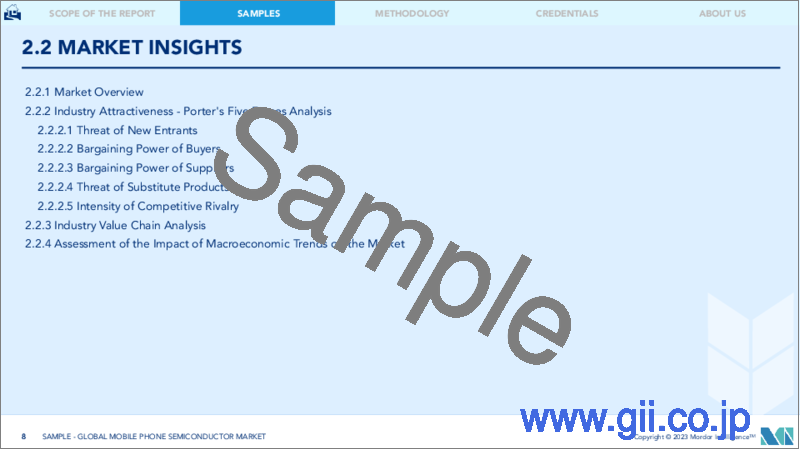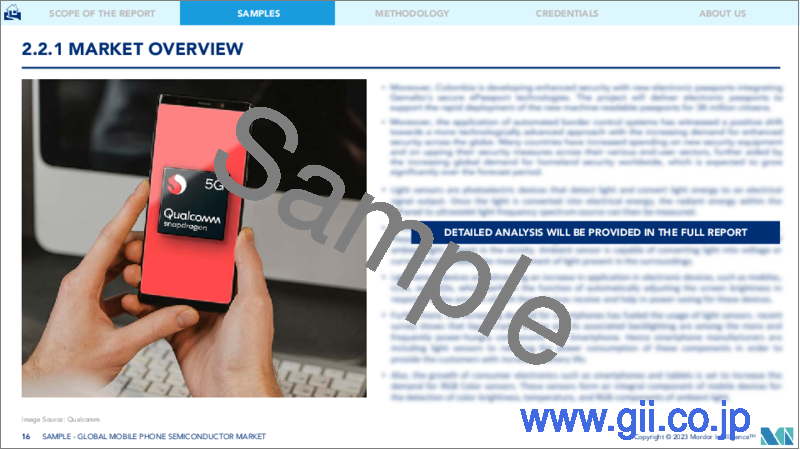|
|
市場調査レポート
商品コード
1197642
携帯電話用半導体市場- 成長、動向、予測(2023年~2028年)Mobile Phone Semiconductor Market - Growth, Trends, and Forecasts (2023 - 2028) |
||||||
|
● お客様のご希望に応じて、既存データの加工や未掲載情報(例:国別セグメント)の追加などの対応が可能です。 詳細はお問い合わせください。 |
|||||||
| 携帯電話用半導体市場- 成長、動向、予測(2023年~2028年) |
|
出版日: 2023年01月23日
発行: Mordor Intelligence
ページ情報: 英文 130 Pages
納期: 2~3営業日
|
- 全表示
- 概要
- 目次
携帯電話用半導体市場は、予測期間中にCAGR7.49%で成長しました。
携帯電話のスマート化、LTEや5Gなどの次世代移動通信規格の急速な導入が、携帯電話向け半導体部品の採用を促進する主な要因となっています。
主なハイライト
- 半導体業界全体の成長は鈍化しており、スマートフォン事業にも変動が見られます。しかし、携帯電話用半導体市場は、スマートフォンにおけるRFベースのアプリケーションの採用が増加したことにより、わずかながら成長を遂げることができました。多くの地域、特にアジア太平洋地域では、スマートフォン・ビジネスが半導体産業の最大の消費者でした。
- 昨年来、スマートフォン業界は成熟期に入りつつあり、それが携帯電話用半導体業界に影響を及ぼしています。しかし、5G技術の登場と政府による5G技術採用の承認により、スマートフォンユーザーは4GやLTE技術をサポートする電話から5G技術への移行が可能になると予想され、研究対象市場にとって大きな機会が創出されるでしょう。
- タブレット、スマートフォン、電子書籍リーダーなどのモバイル機器の出荷台数が増加しており、これらの機器に搭載されるアプリケーションプロセッサ、モデム、MEMSセンサ、無線接続IC、オーディオICなど、さまざまな半導体部品の成長を牽引しています。
- RFの増収は、スマートフォンのASPの増加に支えられた、より多くのバンド間、より多くのキャリアの集約、より高次のMIMO構成の採用の拡大から生み出されました。この傾向は2019年も続き、6GHz以下の5Gの中間帯域や一部の5Gスマホに搭載されるmmWaveモジュールが追加されると予想されました。
- 半導体サプライチェーンの変化、米国・中国貿易戦争、ロシア・ウクライナ戦争による市場の変動、ビジネスモデルの転換などが、一部のメーカーにチャンスをもたらす一方で、他のメーカーには脅威となっています。
- しかし、COVID-19の世界の大流行により、特にアジア太平洋地域におけるサプライチェーンと生産が混乱しました。過去20~30年にわたりアジア太平洋が世界の生産拠点であった結果、主要な半導体製造業は大きな影響を受けています。
携帯電話用半導体市場の動向
市場を大きく牽引するメモリ
- スマートフォンなどの最終端末におけるクラウドコンピューティングやバーチャルリアリティなどの技術的進歩が、この分野の成長の大部分を牽引すると思われます。また、DRAMやNANDフラッシュメモリの平均販売単価の大幅な上昇も収益に貢献します。
- 一般的に、予想される価格低下は、フラッシュメモリおよびDRAMの新しい容量によって相殺され、その結果、これらのデバイスの需給バランスが改善し、エンタープライズソリッドステートドライブ(SSD)、拡張現実およびバーチャルリアリティ、人工知能、グラフィックス、その他の複雑なリアルタイムワークロード機能などの最新のアプリケーションをサポートすることになると考えられます。
- しかし、新興のメモリ技術は、業界のDRAM需要の巨大なチャンクをカニバリゼーションする態勢を整えています。2022年8月、マイクロン・テクノロジー社は、2030年までに400億米ドルを投じて、米国での半導体生産能力を拡大する計画を発表しました。
- マイクロンのDRAMチップは、スマートフォンからデータセンターのサーバーまで、さまざまな機器の用途に使用されています。同社の米国での製造部門拡大計画は、CHIPSおよびScience Actに基づく様々な控除や補助金によって支援される見込みです。このような同社の取り組みにより、携帯電話用半導体市場のメモリ需要が促進され、予測期間中の携帯電話用半導体市場を後押しするものと期待されます。
アジア太平洋地域が携帯電話用半導体市場で優位なポジションを占める
- アジア太平洋地域は、携帯電話および半導体技術の主要市場のひとつです。この地域は、半導体とスマートフォンの製造分野を支配しています。両市場における主要企業のほとんどはアジア太平洋地域に拠点を置いており、残りの企業もアジア太平洋地域に進出しています。
- また、世界の半導体市場もこの地域が支配しています。新興国を中心にスマートフォンや半導体の生産が増加していることも、同地域のモバイル用半導体需要を増大させています。インド、ベトナム、タイ、シンガポールなどの国々は、この地域に製造工場を設置するスマートフォン・メーカーが増加していることを目の当たりにしています。
- 例えば、2022年11月、Appleは、インド政府による「Make in India」イニシアティブの下、インドに最大級の製造ユニットを開設する計画を発表しました。この新しい製造部門は、アップルにとってこの地域で最大の製造部門となる見込みです。このような同社の取り組みにより、同地域の携帯電話用半導体市場が活性化することが期待されます。
- 中国、韓国、日本、シンガポール、台湾は、この地域で高度に発展した半導体生産国の一部です。しかし、マレーシアやインドのような国も潜在的な市場として台頭してきています。これらの国では、スマートフォン市場も巨大であるため、市場調査においても大きな機会を提供することができます。マレーシアは、半導体輸出の重要な市場の1つとして浮上しています。
- 2021年5月、韓国は今後10年間で約4500億米ドルを投じて世界最大のチップ製造基地を建設するという野心的な計画を発表しました。中国と米国に続き、この主要技術を支配するための世界の競争になっています。さらに、さまざまな大手企業が携帯電話用半導体市場にシフトしているため、携帯電話用半導体市場の競争は激化しています。
携帯電話用半導体市場の競合他社分析
携帯電話用半導体市場は、複数の大手企業によって支配されており、非常に断片化された市場です。イノベーションに重点を置いた大企業の様々な買収や提携が行われ、間もなく行われると予想されます。市場の主要プレイヤーには、Samsung ElectronicsやQualcomm Technologies, Inc.などがいます。これらの企業は、市場シェアを拡大し、収益性を高めるために、戦略的な協力体制を活用しています。
- 2022年8月-Micron Technology Inc.は、米国での半導体生産能力を拡大するために2030年までに400億米ドルを投じる計画を発表しました。この新製造部門は、同社が同市場における製造能力を高めるのに役立つと期待されています。
その他の特典
- エクセル形式の市場予測(ME)シート
- アナリストによる3ヶ月間のサポート
目次
第1章 イントロダクション
- 調査の前提条件と市場の定義
- 調査対象範囲
第2章 調査手法
第3章 エグゼクティブサマリー
第4章 市場力学
- 市場概要
- 市場促進要因と抑制要因のイントロダクション
- 市場促進要因
- 次世代移動通信規格であるLTEや4Gの急速なイントロダクション
- マルチコム・ソリューションの登場
- 市場抑制要因
- 製造の複雑さ
- 消費者の需要が工場のキャパシティを超える
- 業界の魅力- ポーターのファイブフォース分析
- 買い手の交渉力
- 供給企業の交渉力
- 新規参入業者の脅威
- 代替品の脅威
- 競争企業間の敵対関係
- 産業バリューチェーン分析
- COVID-19の市場への影響度評価
第5章 市場のセグメンテーション
- コンポーネントタイプ
- モバイルプロセッサー
- メモリ
- ロジックチップ
- アナログ
- 地域別
- 北米
- 欧州
- アジア太平洋地域
- ラテンアメリカ
- 中東
第6章 競合情勢
- 企業プロファイル
- Samsung Electronics
- Qualcomm Technologies, Inc.
- MediaTek Inc.
- NXP Semiconductors N.V.
- Broadcom Inc.
- Skyworks Solutions Inc.
- Intel Corporation
- Huawei Technologies Co. Ltd
- Micron Technology Inc.
- Qorvo Inc.
第7章 投資分析
第8章 市場機会と将来動向
The Mobile Phone Semiconductor Market grew at a CAGR of 7.49% during the forecast period. The increasing adoption of smart technologies in mobile phones and the rapid introduction of next-generation mobile-communications standards, like LTE or 5G, are some of the major factors driving the adoption of semiconductor components in mobile phones.
Key Highlights
- The overall semiconductor industry witnessed lesser growth, and the smartphone business was also fluctuating. However, the mobile phone semiconductor market was able to witness marginal growth, owing to the increasing adoption of RF-based applications in smartphones. In many regions, especially Asia-Pacific, the smartphone business was the largest consumer of the semiconductor industry.
- Since the past year, the smartphone industry has been witnessing a nearing maturity state which is affecting the mobile phone semiconductor industry. However, with the advent of 5G technology and the government's approval for the adoption of 5G technology, it is expected to enable smartphone users to shift from phones supporting 4G and LTE technology to 5G technology which would create huge opportunities for the studied market.
- With the increasing shipments of mobile devices such as tablets, smartphones, and e-book readers have been growing and are driving the growth for a range of semiconductor components, including applications processors, modems, MEMS sensors, wireless connectivity ICs, and audio ICs in these devices.
- The increased revenue of RF was generated from its growing adoption among more bands, a larger number of carriers aggregated, and higher-order MIMO configurations supported by an increase in smartphone ASPs. This trend was expected to continue in 2019, with the addition of the mid-band spectrum for sub-6GHz 5G and mmWave modules in some 5G phones.
- Changes in the semiconductor supply chain, the market fluctuation due to the US-China trade war, the Russia-Ukrain war, and the shifting business models created opportunities for some manufacturers while posing a threat to others.
- However, the significant outbreak of the COVID-19 pandemic globally disrupted the supply chain and production, especially in the Asia-Pacific region. Major semiconductor manufacturing industries have been significantly affected as a result of Asia-Pacific being a world production center over the past two to three decades.
Mobile Phone Semiconductor Market Trends
Memory to Significantly Drive the Market
- A large portion of the growth in this segment would be driven by ongoing technological advancements such as cloud computing and virtual reality in end devices such as smartphones. Sharply higher average selling prices (ASPs) for dynamic random access memory (DRAM) and NAND flash chips also substantially generate revenues.
- In general, the expected price decreases would be offset by new capacity for flash memory and for DRAM, which would result in a better balance of supply and demand for these devices to support more latest applications such as enterprise solid-state drives (SSDs), augmented and virtual reality, artificial intelligence, graphics, and other complexes, real-time workload functions.
- However, emerging memory technologies are poised to cannibalize huge chunks of the DRAM demand in the industry. In August 2022, Micron Technology Inc., announced its plan to spend USD 40 billion through 2030 to expand its semiconductor production capacity in the United States.
- Micron's DRAM chips are used for applications in a variety of devices ranging from smartphones to data center servers. The company's plan to expand its manufacturing unit in the United States is expected to be supported by various credits and grants under the CHIPS and Science Act. Such initiatives by the company is expected to promote the demand for memory in the market providing a positive push to the mobile phone semiconductor market during the forecast period.
Asia-Pacific to Hold a Dominant Position in the Mobile Phone Semiconductor Market
- Asia-Pacific is one of the major markets for mobile phone and semiconductor technologies. The region is dominating semiconductor and smartphone manufacturing fields. Most of the major companies, in both the markets, are based in the Asia-Pacific region, while the remaining companies have a presence in the region.
- The region also dominates the global semiconductor market. The increasing smartphone and semiconductor production, especially in emerging countries, is also augmenting the mobile semiconductor demand in the region. Countries like India, Vietnam, Thailand, and Singapore, among others, are witnessing an increasing number of smartphone manufacturers setting up their manufacturing plants in the region.
- For instance, in November 2022, Apple announced its plan to open one of its largest manufacturing unit in India under the 'Make in India' initiative by the Indian Government. The new manufacturing unit is expected to be Apple's largest manufacturing unit in the region. Such initiatives by the company in the region are expected to ppromote the mobile pone semiconductor market in the region.
- China, South Korea, Japan, Singapore, and Taiwan are some of the highly developed semiconductor producers in the region. However, countries, like Malaysia and India, are also emerging as potential markets. The smartphone market is also massive in these countries; hence, they can offer enormous opportunity for the market studied too. Malaysia is emerging as one of the vital semiconductor export markets.
- In May 2021, South Korea announced its ambitious plans to spend roughly USD 450 billion to build the world's biggest chipmaking base over the next decade. joining China and the U.S. in a global race to dominate the key technology. Moreover, with the shift of various major companies to the
Mobile Phone Semiconductor Market Competitor Analysis
The Mobile Phone Semiconductor Market is a highly fragmented market, dominated by several major players. Various acquisitions and collaborations of large companies have taken place and are expected to take place shortly, which focus on innovation. Some of the key players in the market are Samsung Electronics and Qualcomm Technologies, Inc. These companies are leveraging strategic collaborative initiatives to increase their market share and increase their profitability.
- August 2022 - Micron Technology Inc. announced its plan to spend USD 40 billion through 2030 to expand its semiconductor production capacity in the United States. The new manufacturing unit is expected to help the company to increase its manufacturing capabilities in the market.
Additional Benefits:
- The market estimate (ME) sheet in Excel format
- 3 months of analyst support
TABLE OF CONTENTS
1 INTRODUCTION
- 1.1 Study Assumptions and Market Definition
- 1.2 Scope of the Study
2 RESEARCH METHODOLOGY
3 EXECUTIVE SUMMARY
4 MARKET DYNAMICS
- 4.1 Market Overview
- 4.2 Introduction to Market Drivers and Restraints
- 4.3 Market Drivers
- 4.3.1 Rapid Introduction of Next-generation Mobile-communications Standard, LTE or 4G
- 4.3.2 Emergence of 'Multicom' Solutions
- 4.4 Market Restraints
- 4.4.1 Complexity Regarding Manufacturing
- 4.4.2 Consumer Demand Exceeding Factory Capacity
- 4.5 Industry Attractiveness - Porter's Five Forces Analysis
- 4.5.1 Bargaining Power of Buyers
- 4.5.2 Bargaining Power of Suppliers
- 4.5.3 Threat of New Entrants
- 4.5.4 Threat of Substitute Products
- 4.5.5 Intensity of Competitive Rivalry
- 4.6 Industry Value Chain Analysis
- 4.7 Assessment of Impact of COVID-19 on the Market
5 MARKET SEGMENTATION
- 5.1 Component Type
- 5.1.1 Mobile Processors
- 5.1.2 Memory
- 5.1.3 Logic Chips
- 5.1.4 Analog
- 5.2 Geography
- 5.2.1 North America
- 5.2.2 Europe
- 5.2.3 Asia Pacific
- 5.2.4 Latin America
- 5.2.5 Middle East
6 COMPETITIVE LANDSCAPE
- 6.1 Company Profiles
- 6.1.1 Samsung Electronics
- 6.1.2 Qualcomm Technologies, Inc.
- 6.1.3 MediaTek Inc.
- 6.1.4 NXP Semiconductors N.V.
- 6.1.5 Broadcom Inc.
- 6.1.6 Skyworks Solutions Inc.
- 6.1.7 Intel Corporation
- 6.1.8 Huawei Technologies Co. Ltd
- 6.1.9 Micron Technology Inc.
- 6.1.10 Qorvo Inc.




